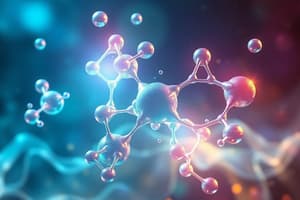Podcast
Questions and Answers
Which of the following best describes the primary reason atoms form chemical bonds?
Which of the following best describes the primary reason atoms form chemical bonds?
- To increase their overall positive charge.
- To achieve a stable electron configuration, similar to a noble gas. (correct)
- To increase their kinetic energy.
- To repel other atoms and create space.
What type of chemical bond is primarily formed through the sharing of electrons between atoms?
What type of chemical bond is primarily formed through the sharing of electrons between atoms?
- Dipole-dipole interaction
- Covalent bond (correct)
- Hydrogen bond
- Ionic bond
Which of the following is an example of a primary bond?
Which of the following is an example of a primary bond?
- Hydrogen bond
- Dipole-dipole interaction
- Ionic bond (correct)
- London Dispersion Force
What differentiates a single covalent bond from a double covalent bond?
What differentiates a single covalent bond from a double covalent bond?
Which of these intermolecular forces is considered the strongest type of secondary bond?
Which of these intermolecular forces is considered the strongest type of secondary bond?
What characteristic of a molecule leads to dipole-dipole interactions?
What characteristic of a molecule leads to dipole-dipole interactions?
Which type of interaction is primarily responsible for the attraction between nonpolar molecules?
Which type of interaction is primarily responsible for the attraction between nonpolar molecules?
How do secondary bonds differ from primary bonds in terms of strength?
How do secondary bonds differ from primary bonds in terms of strength?
Flashcards
Chemical Bonds
Chemical Bonds
Forces that hold atoms together in molecules, leading to the formation of compounds.
Why do atoms form chemical bonds?
Why do atoms form chemical bonds?
Atoms achieve a stable electron configuration by gaining, losing, or sharing electrons with other atoms.
Primary Bonds
Primary Bonds
Strong bonds that hold atoms together within molecules, forming the basic structure of a compound.
Ionic Bond
Ionic Bond
Signup and view all the flashcards
Covalent Bond
Covalent Bond
Signup and view all the flashcards
Secondary Bonds
Secondary Bonds
Signup and view all the flashcards
Hydrogen Bonding
Hydrogen Bonding
Signup and view all the flashcards
London Dispersion Forces
London Dispersion Forces
Signup and view all the flashcards
Study Notes
Chemical Bonds
- Chemical bonds are forces that hold atoms together in molecules.
- Chemical bonds are strong bonds that are difficult to break.
- Water is an example of a molecule held together by chemical bonds.
Why do atoms form chemical bonds?
- Atoms form chemical bonds in order to achieve a stable electron configuration, like that of a noble gas.
- To achieve this stable state, they either gain, lose, or share electrons.
Types of Chemical Bonds
- There are two main types of chemical bonds: primary bonds and secondary bonds.
- Primary bonds are strong bonds that hold atoms together in molecules.
- Secondary bonds are weaker bonds that hold molecules together.
- Primary bonds are further categorized as:
- Ionic Bonds: Formed by the transfer of electrons from one atom to another, resulting in an electrostatic attraction between oppositely charged ions.
- Covalent Bonds: Formed by the sharing of electrons between two atoms, resulting in a more stable configuration for both atoms.
- Single Covalent Bond: Two atoms share one pair of electrons.
- Double Covalent Bond: Two atoms share two pairs of electrons.
- Triple Covalent Bond: Two atoms share three pairs of electrons.
Secondary Bonds
- Secondary bonds are weaker than primary bonds, but significant in determining properties like melting point and boiling point. Types of secondary bonds include:
- Hydrogen Bonding: Strongest type of secondary bond involving a hydrogen atom covalently bound to a highly electronegative atom (like oxygen, nitrogen, or fluorine) and attracted to the lone pair of electrons on another electronegative atom.
- Dipole-Dipole Interactions: Attraction between polar molecules with permanent dipoles.
- London Dispersion Forces: Temporary, weak attractions arising from temporary fluctuations in electron distribution in nonpolar molecules.
Key Summary Points
- Chemical bonds arise from the interaction between electrons in atoms.
- Primary bonds, such as ionic and covalent bonds, are the strongest and hold atoms together within molecules.
- Secondary bonds like hydrogen bonds, dipole-dipole interactions, and London Dispersion Forces, are weaker than primary bonds and are responsible for intermolecular attractions, influencing physical properties.
- Understanding chemical bonds is crucial for comprehending the structure, properties, and reactions of matter.
Studying That Suits You
Use AI to generate personalized quizzes and flashcards to suit your learning preferences.




